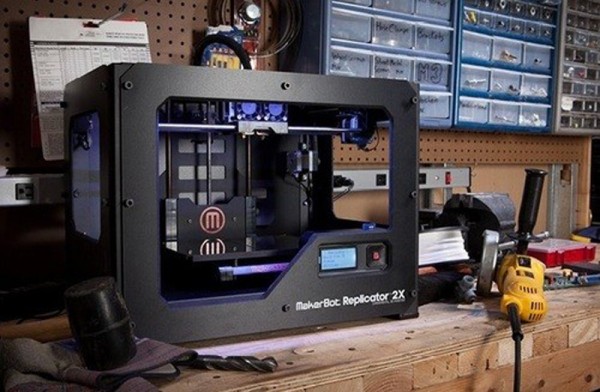· 3D Hardware
· 3D Software
· 3D Video
· 3D TV and Movies
· 3D Art
· 3D Picture of the Day
· 3D Modeling
· 3D Printing
· Reviews
· Gaming
· How To
· News
· Everything Else
· Off Topic
· Around the Web
· Virtual Reality
Posted by: Jesse on: 01/10/2013 02:42 AM
Makerbot’s line of Replicator 2 3D printers has been wildly successful, and today at CES, the company released their new and improved line, the Replicator 2x Experimental 3D Printer.
This is not just a tuned version of the Replicator 2, no, this new printer incorporates some major elements that 3D printers have, until now, been unable to give their consumers.
There are literally too many to list, so here is what Makerware said on their blog:
Colors
The most obvious, and by far the simplest, use of dual extruders is to enable two color printing. Although a single-color object could be painted, there are times when painting a particular object would require a great deal skill or be very time consuming. While printing a plastic sushi set for my daughter I used dualstrusion to add black plastic “soy sauce” to white plastic dishes. Sometimes, painting an object might even be impossible. Imagine an object such as a bottle, vase, or an egg where you want to have an image or design inside. While it might be impossible to paint inside such an object, the interior image could be printed inside the object as it is being created.
Dissolvable Support
Dual extruders allow for printing with a dissolvable support material like PVA. Being able to print with a water soluble material means your robot could print entire mechanical devices complete with moving pieces.
Varying Densities
With two extruders it would be possible to create an entirely solid plastic object with a customizable density. This could be used to make trick dice, a balancing toy, a toy that can’t be knocked down, a toy that can’t be stood up, or maybe a boat that is difficult to sink.
Mechanical Properties
Different extruded materials, such as ABS and PLA plastics, tend to have different physical and mechanical properties. ABS tends to be more flexible and PLA tends to be more rigid. A 3D printer with dualstrusion can combine the two plastics into a single object that is both flexible and rigid.
Simultaneous Dual Printing
One of the more exciting developments with dual extruder printing was a recent contribution by Thingiverse user thorstadg. Thorstadg created a method for operating both extruders simulanteously– allowing the printer to print two objects, one with each extruder, at the same time.
Variable Resolution
Two extruders means you have two nozzles at your disposal. However, there is no particular reason for both extruders to have the same size nozzle aperture. With one very fine nozzle aperture and one relatively large nozzle aperture, a single object could be printed with quick printing coarse features and very high resolution features that take more time.

This is a very smart move on behalf of Makerbot. No other printer on the market has as many useful features as the Rep 2x does, and we can’t wait to get our hands on one.
This is not just a tuned version of the Replicator 2, no, this new printer incorporates some major elements that 3D printers have, until now, been unable to give their consumers.
There are literally too many to list, so here is what Makerware said on their blog:
Colors
The most obvious, and by far the simplest, use of dual extruders is to enable two color printing. Although a single-color object could be painted, there are times when painting a particular object would require a great deal skill or be very time consuming. While printing a plastic sushi set for my daughter I used dualstrusion to add black plastic “soy sauce” to white plastic dishes. Sometimes, painting an object might even be impossible. Imagine an object such as a bottle, vase, or an egg where you want to have an image or design inside. While it might be impossible to paint inside such an object, the interior image could be printed inside the object as it is being created.
Dissolvable Support
Dual extruders allow for printing with a dissolvable support material like PVA. Being able to print with a water soluble material means your robot could print entire mechanical devices complete with moving pieces.
Varying Densities
With two extruders it would be possible to create an entirely solid plastic object with a customizable density. This could be used to make trick dice, a balancing toy, a toy that can’t be knocked down, a toy that can’t be stood up, or maybe a boat that is difficult to sink.
Mechanical Properties
Different extruded materials, such as ABS and PLA plastics, tend to have different physical and mechanical properties. ABS tends to be more flexible and PLA tends to be more rigid. A 3D printer with dualstrusion can combine the two plastics into a single object that is both flexible and rigid.
Simultaneous Dual Printing
One of the more exciting developments with dual extruder printing was a recent contribution by Thingiverse user thorstadg. Thorstadg created a method for operating both extruders simulanteously– allowing the printer to print two objects, one with each extruder, at the same time.
Variable Resolution
Two extruders means you have two nozzles at your disposal. However, there is no particular reason for both extruders to have the same size nozzle aperture. With one very fine nozzle aperture and one relatively large nozzle aperture, a single object could be printed with quick printing coarse features and very high resolution features that take more time.
This is a very smart move on behalf of Makerbot. No other printer on the market has as many useful features as the Rep 2x does, and we can’t wait to get our hands on one.

